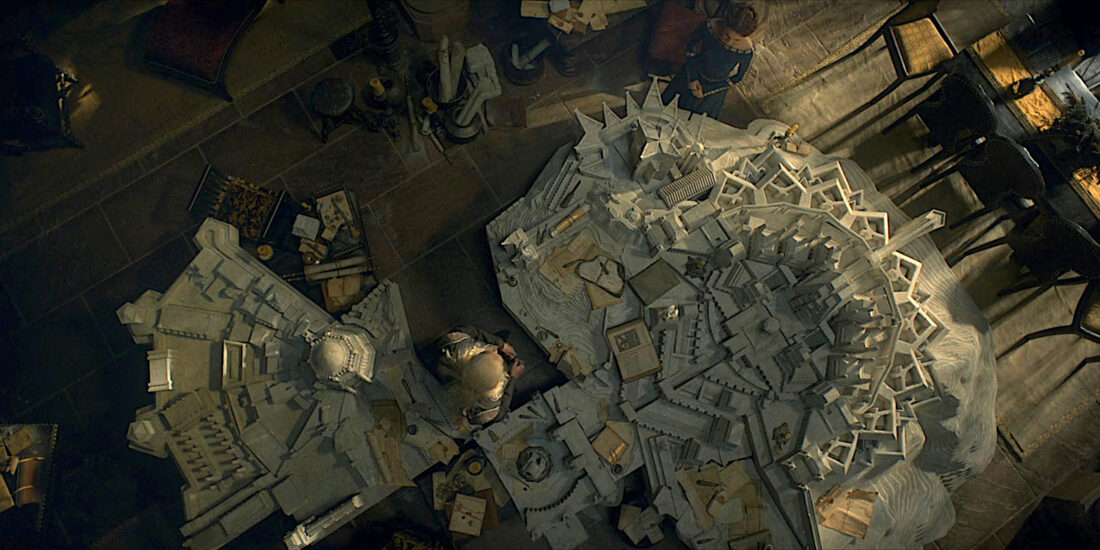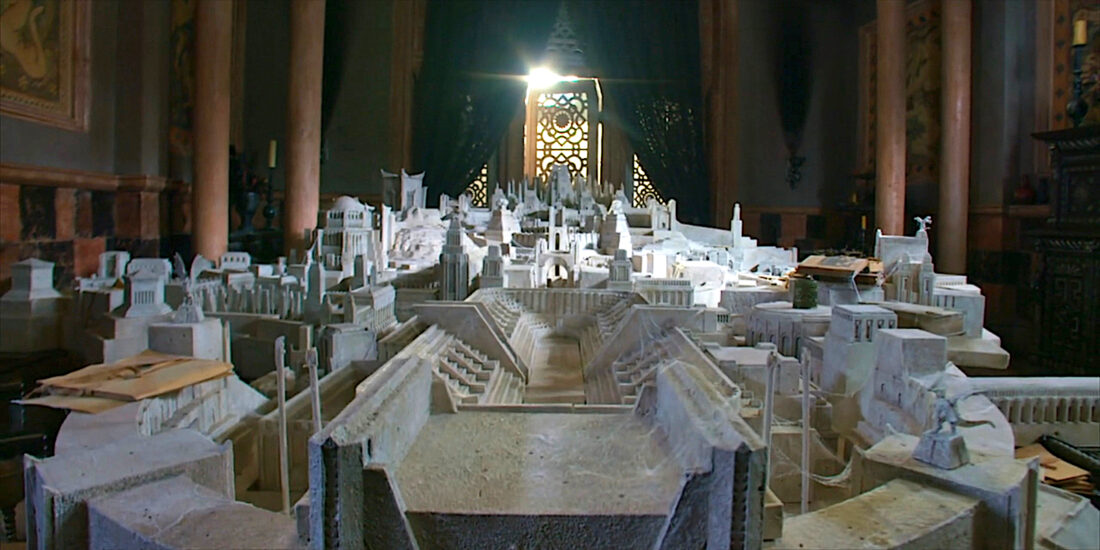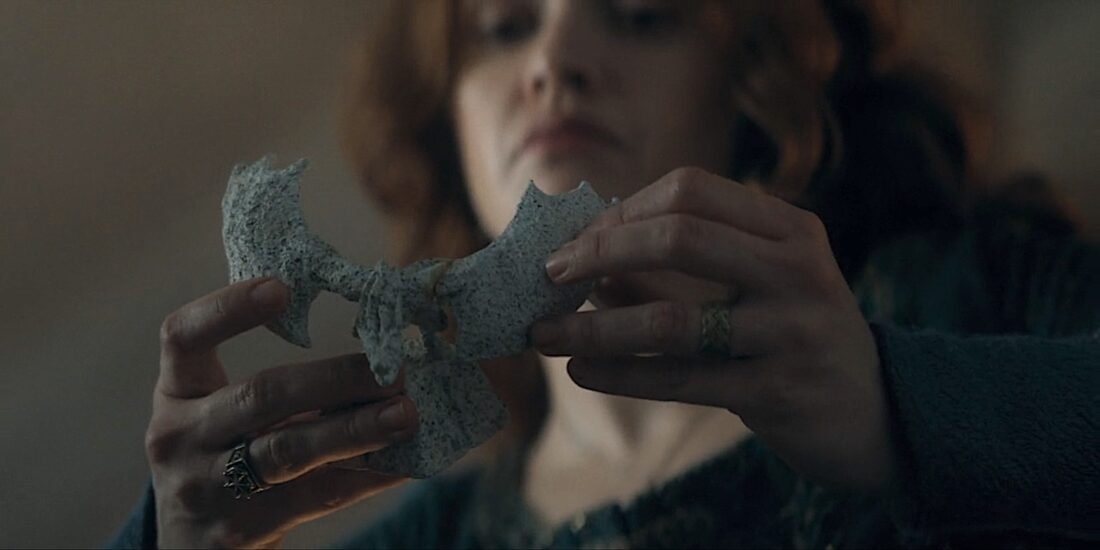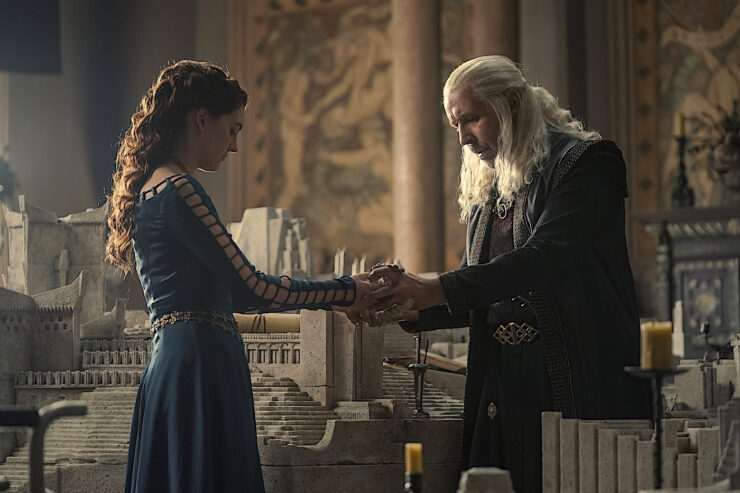Welcome to Close Reads! Leah Schnelbach and guest authors will dig into the tiny, weird moments of pop culture—from books to theme songs to viral internet hits—that have burrowed into our minds, found rent-stabilized apartments, started community gardens, and refused to be forced out by corporate interests. This time out, Michelle Jaworski sings a song of models and madness, and draws our attention to House of the Dragon‘s greatest hobbyist, King Viserys I, and his ridiculously detailed model of Old Valyria.
Warning: This article contains spoilers for House of the Dragon Season 2.
It was perhaps the greatest empire the known world had ever seen. Marble carved into a marvel, ever-expanding (almost greedily so) with dragons overlooking its walls and labyrinth-esque city, it seemed to grow every time we saw it on our screens. It captivated us, yes, but nobody as much as its maker. Except now, his corpse is barely cold, and his vast creation is no more: Destroyed in a “cataclysm” brought on by a multitude of factors, but mostly the fiery rage of a dragon.
I’m not here to mourn Old Valyria, the ancient and extinct stronghold that the ancestors of House Targaryen and House Velaryon once called home. No human or dragon who could’ve witnessed it is still alive to tell us what happened—not even Vhagar, born decades after its destruction and whose first rider, Visenya Targaryen, helped conquer Westeros. And Westerosi historians still have no idea which prevailing theory (a natural disaster of epic proportions, magic, Valyrian hubris, among others) led to its Doom.

Rather, I’m here to mourn King Viserys I Targaryen’s (Paddy Considine) stone model of Old Valyria, which was destroyed in the opening minutes of House of the Dragon Season Two, Episode 2. An ever-present set piece in Viserys’ chambers during Season One, it was destroyed by his enraged and grief-stricken son Aegon (Tom Glynn-Carney) after learning that assassins murdered his son and heir Jaehaerys in the Season Two premiere; if you were near the room as he learned of his son’s fate, you could hear him cry out, “I’ll kill them! I’ll kill them all!” The destruction led Considine to cheekily chide Glynn-Carney for smashing it to bits, telling him on Instagram last week, “That took me f@@@ing years to make.” (Glynn-Carney responded in a comment, calling it “shoddy workmanship 
I’ve been drawn to Viserys’ old model since I first saw it appear in House of the Dragon. There’s no basis in George R.R. Martin’s Fire & Blood for why Viserys Targaryen became consumed with recreating Old Valyria the way someone might build expansive model railroads and gigantic LEGO sets as a hobby, customizes Warhammer miniatures, or really gets into Roblox a la Child Colin Robinson; Considine called it “Viserys’ train set” in a Season One episode of the behind-the-scenes docuseries The House That Dragons Built. (Massive shout out to the HotD crew, who masterfully designed, 3D-printed, and put each piece together over several months!) But this quirk of Considine’s Viserys persisted throughout the first season, endearing him to us in a way that many of his actions—whether it’s how he treated his family when they irked him or how his body continued to fall apart before our eyes—could not.
The Old Valyria model appeared as early as House of the Dragon’s first episode. Following his first wife Aemma’s (Sian Brooke) death, Viserys used it to escape his duties and his grief. Otto Hightower (Rhys Ifans) weaponized his obsession by employing a young Alicent (Emily Carey) to wear her mother’s dress and bond with him over the model in hopes that Viserys would eventually wed her. Alicent commended him on his work, but Viserys deflected on taking sole credit for the model’s creation.
“I only pore over the histories and provide the plans,” Viserys explained. “The stonemasons build the structures.”
As he relayed the history of Old Valyria to Alicent and informed her that “the glory of Old Valyria will never be seen again,” he dropped a stone dragon figurine on the ground. It broke, and while Alicent got it repaired for him, it’s definitely not an ominous sign of things to come.
“Viserys is not into dragon-riding,” co-creator and showrunner Ryan Condal said on The House That Dragons Built. “He takes a more intellectual pursuit. The idea is that he’s gone back to all the old texts and maps and has painstakingly recreated it.”
That wasn’t a kid-friendly stone-carved mode of Old Valyria; it was an adult stone-carved model of Old Valyria. You know that Viserys has yelled at his children and grandchildren multiple times to stop running around his damn model, to stop touching it, and to move as far away from it as possible from it because That model is not a toy, and You will know pain if you break any part of it or whatever else he might’ve said. The Red Keep servants probably weren’t allowed to touch it, either. By the end of Viserys’ life, you can see the neglect by the cobwebs forming on the tops of buildings. The structures were less detailed, signs that the king’s health deteriorated so much that he could no longer indulge in his main hobby. Instead, the king’s final outburst of energy was directed toward a slow walk to the Iron Throne, a symbol made with Valyrian might.

Who knows how many hundreds, if not thousands, of gold dragons Viserys invested in it over the 20-plus years we’ve watched it across Season One. Who knows of the tireless hours the probably underpaid stonemasons took in crafting it to Viserys’ exact specifications; if we ever learned of Red Keep budget disputes over how much Viserys could spend on upgrades every year, I wouldn’t be surprised. Who knows how much of his life Viserys ultimately devoted to researching, building, and expanding upon a model of an ancient and cursed city he might’ve loved more than several of his kids.
Perhaps Viserys’ second-greatest legacy—the first being king during a largely peaceful reign that ended with a civil war so destructive that it would lead to the dragons’ extinction and the deaths of many of his descendants and relatives—is instantly destroyed by his short-sighted successor.
Given that at least one person hoped Aegon would take the model out as a screw-you to his father, maybe it wasn’t surprising that he smashed it to bits. He was aware enough of Viserys’ feelings about him that, on his way to being crowned, he questioned the last-minute decision to make him heir because he knew his father never liked him. In Season Two, Aegon hadn’t been king long, but he was winning the court of public opinion until he hanged every rat catcher in Red Keep to ensure Cheese’s death—a decision for which Otto ripped him apart.
“Do you never think of your father?” Otto asked in exasperation. “His forbearance, his judiciousness, his… his dignity.”
Otto probably wasn’t speaking of that model stone city, long since decimated; he’s mourning an old friend and the king he could once more easily manipulate. But Aegon’s desire for vengeance and his “wish to spill blood, not ink” are already paving a different path and legacy for House Targaryen. And when Aegon pushes back, Otto weaves in seeds of doubt, almost ensuring that Aegon will continue pursuing a path of violent self-destruction with Ser Criston Cole (Fabien Frankel), Aegon’s newly appointed Hand of the King.

The Cargyll twins, Princess Rhaenys Targaryen (Eve Best), and Meleys were early casualties of that destruction. But if Viserys breaking one figurine of his model dragon in Season 1 might’ve been a harbinger of doom for himself, Aegon’s destruction of all of Old Valyria could be a harbinger of even graver consequences for House Targaryen. Alicent’s accidental breaking of that once-repaired dragon in Episode Four signaled even more doom; at least she only moved Viserys’ old books to another room. Aegon might’ve achieved victory at Rook’s Rest, but it came at a high cost: By the end of the episode, both Aegon and his dragon would lay severely injured.
Viserys Targaryen is kind of like House of the Dragons’ version of Bobby Baccalieri. Despite his high status (albeit higher than Bobby’s), he’s often more interested in his minuscule but rewarding pursuits than the family business. Far more ruthless family members surround him, though he’s been known for his own casual cruelty a time or two. As more conniving characters plot around him, struggling in vain to save an empire as they cling to the past, his death lays bare the rot from within. And the various branches of House Targaryen are besieged with rot: Even if some characters make it out alive at the end of the Dance, House Targaryen will become a shadow of what it once was, with only the ruined remains to remember it.











I’d like a story on the following six months of Umma’s life. She comes back to a very changed domestic world.
Her daughter and her lover are dead. Her slave, the most valuable thing she owned, is no longer hers, and is suddenly expecting pay and time off. Her family thinks she’s gone daft. Her relationship with her neighbors is changed. She’s got an unexplained bag of gold, and doesn’t know why. When people say “tell us about how you met the Emperor” she won’t know what they’re talking about. Her little restaurant is suddenly selling beer.
This book is a domestic story, but it treats the domestic changes that happen as unimportant.
Urgh. I know what you mean about the protagonist. As soon as she expressed shock – shock! – that Rome had slaves, I had to put the book down. (Even if she’s never picked up a history book, surely she’s at least heard of Ben Hur or Spartacus?)
My tolerance for idiot heroes is low.
But what happens to Nicole’s children? Isn’t she worried about them? Is she glad to get back to them? Did they even notice she was gone?
This is the kind of book I would normally like a lot, except for the part where I’d throw it across the room in about thirty pages flat.
Nicole doesn’t annoy me anywhere near as much as she does Jo Walton. Mostly, I think, because I’m a LA lawyer and deal with Nicoles pretty much every day. Even in the highly-educated people I deal with, there’s a pitiable lack of knowledge of history and even less interest. Household Gods remains a favorite for the very reason that Nicole is just a normal, unexceptional person. There are plenty of other books where the time traveler is able to MacGyver his or her way into bringing our tech back to the historical period, but most people I know couldn’t do that. I think the instantly adaptable people we always see in these books are the exception.
TexAnne: Spoiler! Their divorced father has to come back from holiday to look after them — in the real world she’s only in a coma for a week. She misses them a little, but surprisingly little, and she hardly worries about them at all, to her mind they’re safe in the future. In fact she survives because her four year old calls 911. They’re better children than she deserves.
Ursula: Yes, so would I. It was hoping I might get that, or a little of it, at the end of the book, that kept me reading the first time. Umma in LA would also have been nifty.
MichaelK: I don’t think the protagonist of this sort of novel needs to be supercompetent, but are the people you know really unaware that Rome had slaves? I think Nicole is worse than a normal unexceptional and well over into the self-centered and blinkered end of things.
Too bad. I’d have liked to read the Roman scenes, but the protag would totally put me off. If I wanted self centered and ignorant, I could talk to my SiL. ;)
I admit, I was one of the ‘couldn’t finish this’ readers, and had pretty much put it out of my mind. Your description reminds me of one of the Jane Austenish books (Confessions of a JA Addict?), where the protagonist, despite her supposed love of JA books, spends her time in the past either whining about the chamber pots or refusing to believe that she’s really there. Sigh. So what if you are in a coma and dreaming the whole thing? Enjoy the ride, damnit!
Pam Adams @@@@@ 7: Off topic, but you reminded me of the British miniseries Lost In Austen, which I really rather like because she doesn’t spend all her time whinging. She’s stuck in 1811 and she doesn’t necessarily adapt, but she’s willing to stick with it and see where it goes. She’s very aware that she’s in the past and that she could screw with the future (but that doesn’t stop her from sharing her lip gloss). She adopts their customs but only to a point (she sneaks out for smokes, snogs someone she shouldn’t, and kicks an arsehole in front of an entire ballroom). She not only understands the time period from Austen’s work but from paying attention in school. I highly recommend the British cut; the American version on is massively edited down (from 3+ hrs to 1.5).
A pretty random question, but isn’t “Umma” a name of semitic origin? If so, does that play in the story?
Linguistically ignorant: It doesn’t seem to be of semitic origin in the story. However, Jews are mentioned (once) in a relatively positive way, whereas Christians are thought of as being fanatical weirdos.